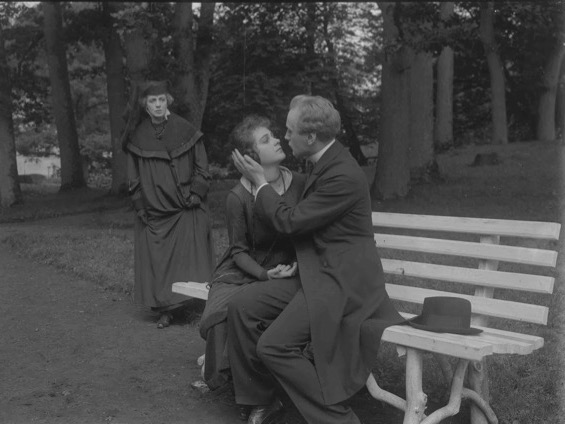THORA VAN DEKEN
(A Mother’s Fight)
John W. Brunius (SE 1920)
When Thora van Deken is called to the deathbed of her divorced husband, Squire Niels Engelstoft, she learns that he has bequeathed a substantial part of his estate to the foundation of a nursing home rather than to their daughter Esther. She pleads with him to revoke his will, but he dies before he can react. Thora takes the matter into her own hands: she steals the will and takes over the estate as Esther’s guardian, claiming that the will was burned in agreement with her late husband before he died. When nasty rumors spread, Thora stands firm, committed to maintaining control of the estate on behalf of her daughter at all costs. But Esther is far less concerned with her inheritance; despite her mother’s attempts to prevent it, Esther falls in love with the young idealistic pastor Bjerring. All Thora’s efforts may have been for nothing.
The film is based on a short novel written in 1900 by the Danish 1917 Nobel Prize laureate Henrik Pontoppidan, Lille Rødhætte (Little Red Riding Hood). It was adapted for the stage in 1914, retitled Thora van Deken. John W. Brunius directed the play in Stockholm in 1916, and his film version features several cast members from that production. Like Synnöve Solbakken, this film, shot in the late summer of 1919, was one of Skandia’s prestige projects aiming to compete with the foremost productions of Svenska Bio. However, the two rival companies would merge into the newly founded Svensk Filmindustri before the film’s release in March 1920.
Again like Synnöve Solbakken, the exteriors of which were shot on location in Norway, Thora van Deken intends to evoke the atmosphere of the literary work’s country of origin. The “Danish” look was captured by shooting the majority of the exteriors in Sweden’s southernmost province, Scania, which has a landscape similar to Denmark’s.
Compared to the filmic style John W. Brunius used in Synnöve Solbakken, whose picturesque tableaux inspired by 19th-century paintings give that film a rather static impression, Thora van Deken is told in a very different manner. Considering Brunius’s previous work with Pontoppidan’s story on stage and the fact that the film is mostly set indoors, it is interesting that here he doesn’t fall into the use of a theatrical tableau staging style. Instead, Thora van Deken, with its first-class camerawork, editing, and narrative structure, is an intense cinematic drama which brilliantly reflects its characters’ psychological conflicts. The elaborate flashback structure of Thora’s meeting with her dying ex-husband in the first two acts of the film bears a close resemblance to the narrative structure of Victor Sjöström’s masterpiece of the following year, The Phantom Carriage (Körkarlen, 1921), a considerable portion of which is told through deathbed flashbacks.
Much of Thora van Deken’s strength undoubtedly rests on Pauline Brunius’s stunning performance in the title role, which is arguably the best of her film career. (Pauline Brunius, who also directed a few films on her own, had only a limited screen acting career and is today best known as a stage diva and the first female director of the Royal Dramatic Theatre in Stockholm.) Interestingly, the film is consistently structured around Thora’s – and, in few scenes, her daughter’s – point of view.
Thora van Deken (released in Britain as A Mother’s Fight) is one of the foremost examples of films by the minor directors of the Swedish “Golden Age”. Yet sadly it has been overshadowed by the work of the masters Stiller and Sjöström in both film history and screening praxis. The latest known showing for a theatre audience was in France in 1985.
The print In 1968 a fine grain master was made from the original camera negative, which no longer exists. To complete the parts of the negative that were missing (the majority of Act 3 and the whole of Act 4), a duplicate negative was struck from a nitrate print. In 2017 the fine grain master and duplicate negative were scanned by the Swedish Film Institute and edited together with full-length intertitles. The tinting scheme of the final DCP is based on a severely deteriorated nitrate print.
Magnus Rosborn, Casper Tybjerg

scen: John W. Brunius, Sam Ask.
photog: Hugo Edlund. scg/des: Vilhelm Bryde, Gustaf Hallén.
cast: Pauline Brunius (Thora van Deken), Hugo Björne (Niels Engelstoft), Jessie Wessel (Esther Engelstoft), Gösta Ekman (pastore/pastor Bjerring), Gösta Cederlund (magistrato/magistrate Sidenius), Oscar Johansson (rettore/principal Brandt), Sam Ask (avvocato/attorney Sandberg).
prod: Filmindustri AB Skandia.
uscita/rel: 15.03.1920.
copia/copy: DCP (da/from 35mm, 1836 m.; orig. 1846 m.), 85′ (trascritto a/transferred at 19 fps), col. (imbibito/tinted); did/titles: SWE.
fonte/source: Svenska Filminstitutet, Stockholm.


 Italiano
Italiano